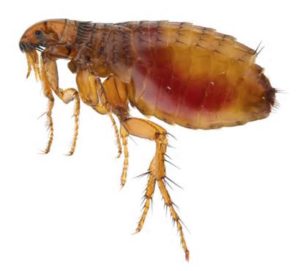How does my pet get tapeworms and how do I get rid of them?

| Tapeworms are long, flat, parasitic worms that live in the intestines of dogs and cats. Several species of tapeworm can infect pets but the most common offender is the tapeworm know as Dipylidium Caninum. An adult tapeworm can reach six inches or more and has the appearance of a white piece of tape or ribbon. |
| Tapeworm segments detach from the end of the adult tapeworm and are shed in the pet’s feces. Each segment contains numerous tapeworm eggs. Once in the environment, the segments break open, releasing the eggs, which will develop into tapeworm larvae. |
 |
The most common tapeworm found in dogs and cats is associated with fleas. While in the environment, flea larvae eat the tapeworm larvae, and pets become infected when they ingest an adult flea while grooming, biting or chewing on their skin. It can take up to one month for the tapeworm larvae to reach maturity and start shedding eggs. |
|
An owner may become aware that his or her pet has tapeworms by finding tapeworm segments stuck to the fur around the pet’s anus, in the pet’s bedding, or in the pet’s feces. When fresh, these segments are white or cream colored, can move and look like grains of rice. As they dry, they look more like sesame seeds. Pets may experience irritation or itchiness around the anus from passing the tapeworm segments. Dogs will sometimes lick their anus, or scoot on the ground, on rugs, or other hard surfaces. |
|
|
Tapeworm eggs may be difficult to detect on a routine fecal exam. In most cases, the eggs are contained within the tapeworm segments, and unless they are broken open, they may not appear on the fecal exam. The most practical way to diagnose the presence of tapeworm is the observation of tapeworm segments. Tapeworms can’t be passed directly from cat to cat, dog to dog, or dog to cat and vise versa. Pets can also become infected with tapeworm from the Genus Taenia when they hunt and eat small rodents. (mice, rats, squirrels or rabbits) that have eaten the tapeworm larvae. |
   |
| Tapeworms do not normally cause serious health problems in dogs and cats. Weight loss may occur if they are heavily infected.
Using flea treatment as a preventative measure can help reduce the risk of your pet eating fleas. Owners should also discourage pets from hunting and eating prey. Tapeworms can be easily treated with one or two doses of a worming medication specific for these parasites. Please call our office at (513)232-4550 if you notice your pet has tapeworms. |


